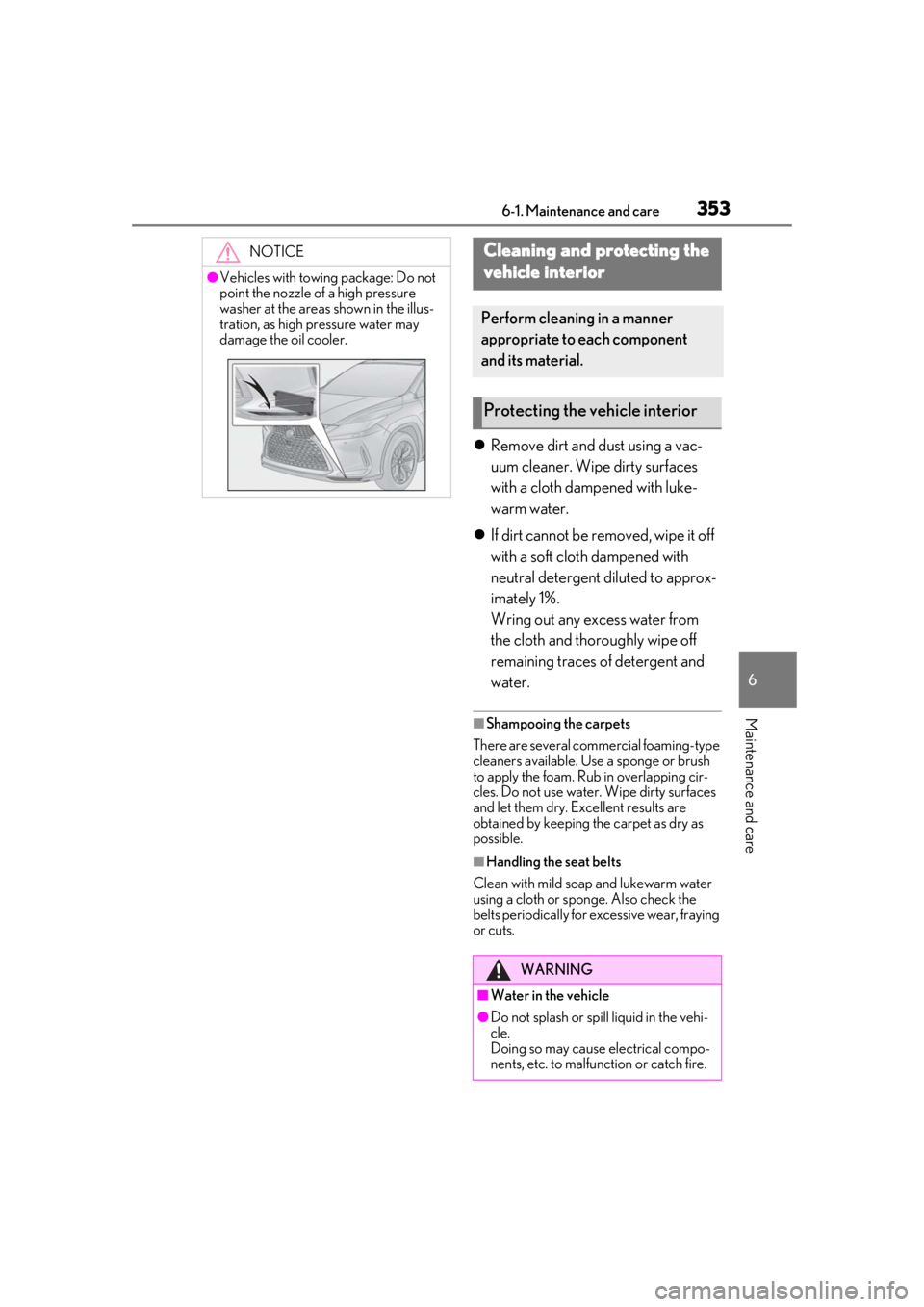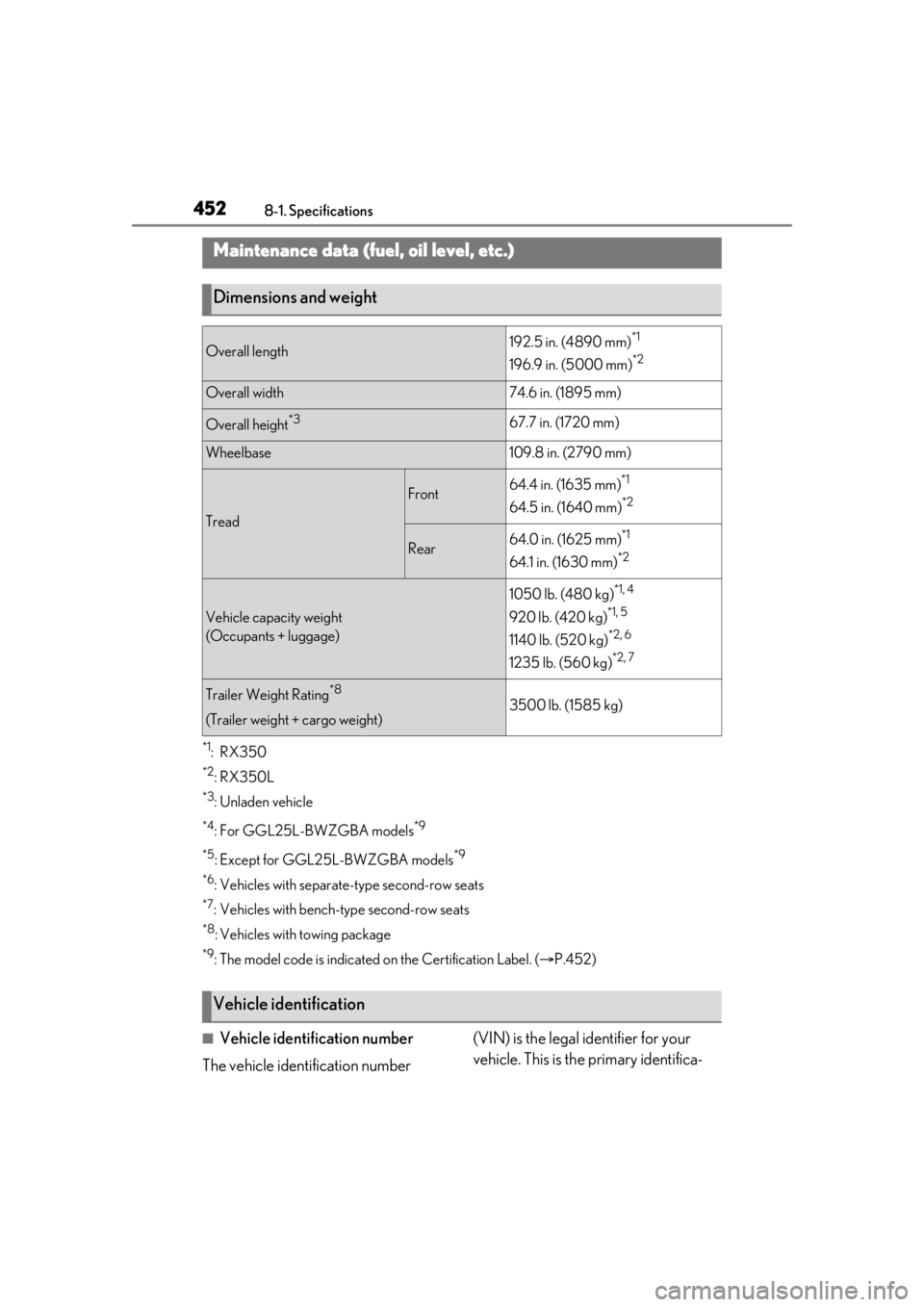2020 LEXUS RX350 oil type
[x] Cancel search: oil typePage 13 of 516

13Pictorial index
Precautions for winter season .....................................................................................P.283
To prevent freezing (windshield wiper de-icer)
*.................................................P.303
Precautions for car wash ................................................................................................ P.351
Fuel filler door ........................................................................................................ P.202
Refueling method ............................................................................................................. P. 202
Fuel type/fuel tank capacity ...... ................................................................................... P.454
Tires.......................................................................................................................... ... P.371
Tire size/inflation pressure ................................................................................. P.371, 457
Winter tires/tire chains ..................................................................................................P.283
Checking/rotation/tire pressure warning system................................................P.371
Coping with flat tires........................................................................................................ P .426
Hood ..........................................................................................................................P.363
Opening ........................................................................................................................ ....... P.363
Engine oil ..................................................................................................................... ......... P.454
Coping with overheating ............................................................................................... P.447
Warning messages .......................................................................................................... P.422
Headlights/front turn signal lights/front side marker lights ............ P.184, 190
Side turn signal lights .............................................................................................P.184
Parking lights/daytime running lights...............................................................P.190
Fog lights/cornering lights
*....................................................................... P.190, 195
Rear side marker lights .........................................................................................P.190
Stop/tail lights ..........................................................................................................P.190
Back-up lights/rear turn signal lights ...................................................... P.184, 190
Shifting the shift lever to R .............................................................................................. P.18 0
License plate lights .................................................................................................P.190
*:If equipped
Light bulbs of the exterior lights for driving
(Replacing method: P.394, Watts: P.458)
E
F
G
H
I
J
K
L
M
N
O
Page 282 of 516

2824-6. Driving tips
4-6.Driving tips
Use fluids that are appropriate to
the prevailing outside temperatures.
•Engine oil
• Engine coolant
•Washer fluid
Have a service technician inspect
the condition of the battery.
Have the vehicle fitted with four
snow tires or purchase a set of tire
chains for the front tires.
Ensure that all tires ar e of the specified size
and the same brand, and that chains match
the size of the tires.
Perform the following according to the
driving conditions:
Do not try to forcibly open a window
or move a wiper that is frozen. Pour
warm water over the frozen area to
melt the ice. Wipe away the water
Winter driving tips
Carry out the necessary prepara-
tions and inspections before driving
the vehicle in winter. Always drive
the vehicle in a manner appropriate
to the prevailing weather condi-
tions.
Pre-winter preparations
WARNING
■Driving with snow tires
Observe the following precautions to
reduce the risk of accidents.
Failure to do so may result in a loss of
vehicle control and cause death or seri-
ous injury.
●Use tires of the specified size.
●Maintain the recommended level of air
pressure.
●Do not drive in excess of 75 mph (120
km/h), regardless of the type of snow
tires being used.
●Use snow tires on all, not just some
wheels.
■Driving with tire chains
Observe the following precautions to
reduce the risk of accidents.
Failure to do so may result in the vehicle
being unable to be driven safely, and may
cause death or serious injury.
●Do not drive in excess of the speed
limit specified for the tire chains being
used, or 30 mph (50 km/h), which-
ever is lower.
●Avoid driving on bumpy road surfaces
or over potholes.
●Avoid sudden acceleration, abrupt
steering, sudden br aking and shifting
operations that cause sudden engine
braking.
●Slow down sufficiently before entering
a curve to ensure that vehicle control is
maintained.
●Do not use the LTA (Lane Tracing
Assist) system.
NOTICE
■Repairing or replacing snow tires
Request repairs or replacement of snow
tires from your Lexus dealer or legitimate
tire retailers.
This is because the removal and attach-
ment of snow tires affects the operation
of the tire pressure warning valves and
transmitters.
Before driving the vehicle
Page 353 of 516

3536-1. Maintenance and care
6
Maintenance and care
Remove dirt and dust using a vac-
uum cleaner. Wipe dirty surfaces
with a cloth dampened with luke-
warm water.
If dirt cannot be removed, wipe it off
with a soft cloth dampened with
neutral detergent diluted to approx-
imately 1%.
Wring out any excess water from
the cloth and thoroughly wipe off
remaining traces of detergent and
water.
■Shampooing the carpets
There are several commercial foaming-type
cleaners available. Use a sponge or brush
to apply the foam. Rub in overlapping cir-
cles. Do not use water. Wipe dirty surfaces
and let them dry. Excellent results are
obtained by keeping the carpet as dry as
possible.
■Handling the seat belts
Clean with mild soap and lukewarm water
using a cloth or sponge. Also check the
belts periodically for excessive wear, fraying
or cuts.
NOTICE
●Vehicles with towing package: Do not
point the nozzle of a high pressure
washer at the areas shown in the illus-
tration, as high pressure water may
damage the oil cooler.
Cleaning and protecting the
vehicle interior
Perform cleaning in a manner
appropriate to each component
and its material.
Protecting the vehicle interior
WARNING
■Water in the vehicle
●Do not splash or spill liquid in the vehi-
cle.
Doing so may cause electrical compo-
nents, etc. to malfunction or catch fire.
Page 366 of 516

3666-3. Do-it-yourself maintenance
than 5 minutes for the oil to drain
back into the bottom of the engine.
2 Holding a rag under the end, pull
the dipstick out.
3 Wipe the dipstick clean.
4 Reinsert the dipstick fully.
5 Holding a rag under the end, pull
the dipstick out and check the oil
level.
Low
Normal
Excessive
The shape of the dipstick may differ
depending on the type of vehicle or
engine.
6Wipe the dipstick and reinsert it
fully.
■Checking the oil type and prepar-
ing the item needed
Make sure to check the oil type and prepare the items needed before add-
ing oil.
Engine oil selection
P.454
Oil quantity (Low Full)
1.9 qt. (1.8 L, 1.6 Imp. qt.)
Item
Clean funnel
■Adding engine oil
If the oil level is below or near the low
level mark, add engine oil of the same
type as that already in the engine.
1 Remove the oil filler cap by turning
it counterclockwise.
2 Add engine oil slowly, checking the
dipstick.
3 Install the oil filler cap by turning it
clockwise.
■Engine oil consumption
A certain amount of engine oil will be con-
sumed while driving. In the following situa-
tions, oil consumption may increase, and
engine oil may need to be refilled in
between oil maintenance intervals.
●When the engine is new, for example
directly after purchasing the vehicle or
after replacing the engine
●If low quality oil or oil of an inappropriate
viscosity is used
●When driving at high engine speeds or
A
B
C
Page 452 of 516

4528-1. Specifications
8-1.Specifications
*1:RX350
*2:RX350L
*3:Unladen vehicle
*4: For GGL25L-BWZGBA models*9
*5
:Except for GGL25L-BWZGBA models*9
*6
: Vehicles with separate -type second-row seats
*7: Vehicles with bench-type second-row seats
*8: Vehicles with towing package
*9: The model code is indicated on the Certification Label. (P.452)
■Vehicle identification number
The vehicle identification number (VIN) is the legal identifier for your
vehicle. This is the primary identifica-
Maintenance data (fuel, oil level, etc.)
Dimensions and weight
Overall length192.5 in. (4890 mm)*1
196.9 in. (5000 mm)*2
Overall width74.6 in. (1895 mm)
Overall height*367.7 in. (1720 mm)
Wheelbase109.8 in. (2790 mm)
Tread
Front64.4 in. (1635 mm)*1
64.5 in. (1640 mm)*2
Rear64.0 in. (1625 mm)*1
64.1 in. (1630 mm)*2
Vehicle capacity weight
(Occupants + luggage)
1050 lb. (480 kg)*1, 4
920 lb. (420 kg)*1, 5
1140 lb. (520 kg)*2, 6
1235 lb. (560 kg)*2, 7
Trailer Weight Rating*8
(Trailer weight + cargo weight)3500 lb. (1585 kg)
Vehicle identification
Page 454 of 516

4548-1. Specifications
■Oil capacity (Drain and refillref-
erence
*)
*: The engine oil capacity is a reference quantity to be used when changing the
engine oil. Warm up and turn off the
engine, wait more than 5 minutes, and
check the oil level on the dipstick.
■Engine oil selection
“Toyota Genuine Motor Oil” is used in
your Lexus vehicle. Use Lexus
approved “Toyota Genuine Motor Oil”
or equivalent to satisfy the following
grade and viscosity.
Oil grade: ILSAC GF-5 multigrade
engine oil
Recommended viscosity: SAE 0W-20
SAE 0W-20 is the best choice for
good fuel economy and good starting
in cold weather. If SAE 0W-20 is not available, SAE
5W-20 oil may be used. However, it
must be replaced with SAE 0W-20 at
the next oil change.
Outside temperature
Oil viscosity (0W-20 is explained here
as an example):
• The 0W in 0W-20 indicates the characteristic of the oil which allows
cold startability. Oils with a lower
value before the W allow for easier
starting of the engine in cold
weather.
• The 20 in 0W-20 indicates the vis- cosity characteristic of the oil when
the oil is at high temperature. An oil
with a higher viscosity (one with a
higher value) may be better suited if
the vehicle is operated at high
speeds, or under extreme load con-
ditions.
Fuel
Fuel typeUnleaded gasoline only
Octane Rating87 (Research Octane Number 91) or higher
Fuel tank capacity
(Reference)19.2 gal. (72.5 L, 15.9 Imp. gal.)
Lubrication system
With filter
Vehicles with towing pack-
age
5.8 qt. (5.5 L, 4.8 Imp. qt.)
Vehicles without towing
package
5.7 qt. (5.4 L, 4.8 Imp. qt.)
Without fil-
ter5.6 qt. (5.3 L, 4.7 Imp. qt.)
A
Page 455 of 516

4558-1. Specifications
8
Vehicle specifications
How to read oil container label:
The International Lubricant Specifica-
tion Advisory Committee (ILSAC)
Certification Mark is added to some oil
containers to help you select the oil you
should use.
*: The coolant capacity is a reference quantity.If replacement is necessary, contact your Lexus dealer.
Cooling system
Capacity*
RX350 (Vehicles without towing package)
9.5 qt. (9.0 L, 7.9 Imp. qt.)
RX350 (Vehicles with towing package)
10.5 qt. (9.9 L, 8.7 Imp. qt.)
RX350L
13.1 qt. (12.4 L, 11 Imp. qt.)
Coolant type
Use either of the following:
“Toyota Super Long Life Coolant”
Similar high-quality ethylene glycol-based non-silicate,
non-amine, non-nitrite, and non-borate coolant with
long-life hybrid orga nic acid technology
Do not use plain water alone.
Ignition system (spark plug)
MakeDENSO FK20HBR8
Gap0.03 in. (0.8 mm)
NOTICE
■Iridium-tipped spark plugs
Use only iridium-tipped spark plugs. Do not adjust the spark plug gap.
Page 456 of 516

4568-1. Specifications
*: The fluid capacity is a reference quantity.If replacement is necessary, contact your Lexus dealer.
Your Lexus vehicle is filled with “Toyota Genuine Differential Gear Oil” at the fac-
tory. Use Lexus approved “Toyota Genuine Di fferential Gear Oil” or an equivalent
of matching quality to satisfy the above specification. Please contact your Lexus
dealer for further details.
Electrical system (battery)
Open voltage at 68°F (20°C):
12.6 V or higher: Fully charged
12.2 12.4 V: Half charged
12.0 V or lower: Discharged
(Turn the engine switch off and turn on the head-
lights for 20 to 30 seconds.)
Charging rates5 A max.
Automatic transmission
Fluid capacity*7.2 qt. (6.8 L, 6.0 Imp. qt.)
Fluid typeToyota Genuine ATF WS
NOTICE
■Transmission fluid type
Using transmission fluid other than “Toyota Genuine ATF WS” may cause deterioration in
shift quality, locking up of your transmission accompanied by vibration, and ultimately
damage the transmission of your vehicle.
Transfer (AWD models)
Oil capacity0.8 qt. (0.8 L, 0.7 Imp. qt.)
Oil type and viscosityToyota Genuine Differential gear oil LT 75W-85 GL-5
or equivalent
Rear differential (AWD models)
Oil capacity0.5 qt. (0.5 L, 0.4 Imp. qt.)
Oil type and viscosityToyota Genuine Differential gear oil LT 75W-85
GL-5 or equivalent